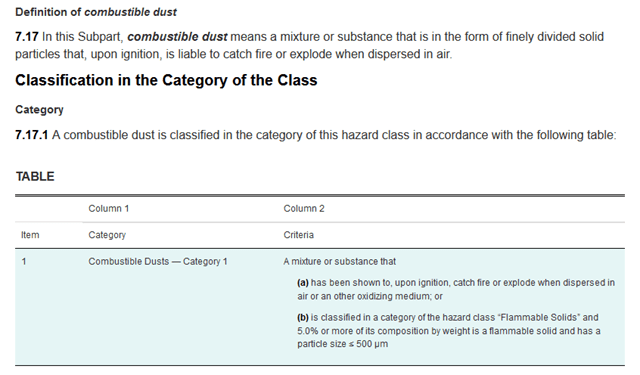Combustible Dusts Criteria – What are the requirements on my SDS?
By: Kirsten Alcock, Manager of Product Safety, email
It wasn’t up until recently that more of us became familiar with the GHS Category for combustible dust. This was not something we had to classify for under the older WHMIS 1988 regulations. Many of my clients have lots of questions surrounding the requirements for the GHS Label but also the NFPA ratings.
Below you will find information taken from the Hazardous Products Regulations in Canada on what a combustible dust is and what the expectation of your SDS and label:
The label requirements for a Combustible Dust in Canada are as follows:
Some clients request help with the determination of the NFPA numbering system when it comes to the combustible dust category. NFPA uses a number system that ranges from 0 to 4 with 4 indicating a severe hazard and 0 indicating a minimal hazard.
If you are including NFPA in your workplace, I would suggest you download the most recent copy of NFPA 704 for your files. Annex D provides clarification on what combustible dust is. In this Annex, they also provide links to some information from OSHA to help when classifying combustible dust.
According to NFPA 704 Standard System for the Identification of the Hazards of Materials for Emergency Response, 2017, a combustible dust is considered to be a finely divided solid material that is 420 micrometers (μm) or smaller in diameter (material passing a U.S. No. 40 Standard sieve) that presents an explosion hazard when dispersed and ignited in air. When this dust becomes suspended in the air, there is a potential risk of a dust cloud ignition leading to a flash fire. Evaluation of the hazard should be determined by means of doing actual test data.
As the NFPA 704 is trademarked, I am not permitted to share pictures from the standard. A combustible dust can be classified as 1,2 or 3 for NFPA. The number will depend on the particle size.
When we author an SDS that we believe needs the category of Combustible dust, we will reach out to ask if you have data. If you need help with the authoring of a SDS that is compliant with Canada or the US, please contact us. We can ensure that your SDS will meet compliance with the GHS and any additional hazard classifications/standards for both of these countries.
Contact:
Dell Tech
Kirsten Alcock, B.Sc. (Hons)
Manager, Product Safety Group
519-858-5074
kirsten@delltech.com
Dell Tech has provided professional, confidential consulting services to the chemical specialty
industry in Canada, the USA, Europe, and Asia for the last 40 years.
Contact us today for more information.







